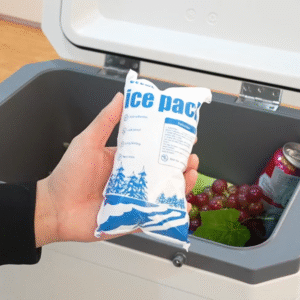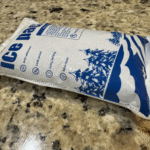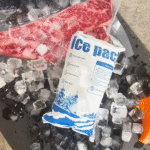Tijolos de gelo seco vs.. Pacotes de gelo seco – o que é melhor para enviar produtos congelados?
Ao enviar produtos perecíveis, como frutos do mar, produtos farmacêuticos, ou amostras biotecnológicas, maintaining an optimal cold chain is crucial. Ambos dry ice bricks and dry ice packs are solid CO2 solutions, ideal for preserving items at sub-zero temperatures. But how do you choose the best option for your specific needs in 2025? Neste guia, we will compare the features, benefícios, and applications of dry ice bricks versus dry ice packs and provide expert recommendations to help you make an informed decision.
-
What are dry ice bricks and dry ice packs, E como eles funcionam?
-
How do you select the best dry ice solution for your shipment?
-
What benefits do dry ice bricks offer over traditional ice packs?
-
How do you ensure compliance with shipping regulations when using dry ice?
-
What are the latest trends and innovations in dry ice shipping for 2025?
What Are Dry Ice Bricks and Dry Ice Packs?
Tijolos de gelo seco:
Dry ice bricks are large, solid blocks of frozen CO2, designed to provide extended cooling durations during long-distance shipments. These bricks are ideal for shipments requiring 48–72 hours or more of cooling, such as for biologics, frutos do mar congelados, e farmacêuticos. The slow sublimation rate of dry ice bricks ensures that the goods within the shipment remain frozen for longer periods.
Pacotes de gelo seco:
Dry ice packs are pre-packaged, flexible sheets or blocks of dry ice. These packs are typically smaller and designed for shorter-duration shipments (12–48 horas). They are commonly used for small shipments or for items that need to be chilled rather than frozen, como chocolates, cosméticos, or small pharmaceutical parcels. Dry ice packs are easier to handle and more adaptable to various package sizes.
How Do Dry Ice Bricks and Packs Compare?
| Recurso | Tijolos de gelo seco | Pacotes de gelo seco |
|---|---|---|
| Duração do resfriamento | Até 72 horas ou mais | Typically 12–48 hours |
| Manuseio | Requer luvas; mais pesado, mais volumoso | Mais fácil de manusear; leve |
| Custo | Generally more expensive | Mais acessível |
| Uso ideal | Envios de longa distância, grandes volumes | Envios de curta distância, small volumes |
| Regulamentos | Must comply with hazardous material shipping laws | Must comply with hazardous material shipping laws |
How to Select the Best Dry Ice Solution for Your Shipment
Principais considerações:
-
Duração da remessa:
-
Para remessas de longa distância (sobre 48 horas), dry ice bricks are the better choice due to their longer cooling duration.
-
Dry ice packs are ideal for shipments that require cooling for up to 48 horas ou menos.
-
-
Tipo de Mercadoria:
-
Sensitive goods like vaccines or biologics that require sub-zero temperatures for extended periods should be shipped with dry ice bricks.
-
Para produtos como chocolates, kits de refeições, or cosmetics that only need to stay chilled, dry ice packs are sufficient.
-
-
Packaging and Space Requirements:
-
Larger shipments with bulkier goods benefit from dry ice bricks, while dry ice packs are more suitable for smaller packages.
-
-
Sensibilidade à temperatura:
-
Dry ice packs are perfect for products that don’t require extreme freezing temperatures but need to stay cold for a short duration.
-
Dry ice bricks provide more consistent cooling and are best suited for critical items that must be kept frozen during transit.
-
What Are the Benefits of Dry Ice Bricks Over Traditional Ice Packs?
Advantages of Dry Ice Bricks:
-
Duração de resfriamento mais longa: Dry ice bricks maintain sub-zero temperatures for up to 72 horas, significativamente mais longo do que as bolsas de gelo tradicionais, which typically last only 12-24 horas.
-
Sem danos causados pela água: Traditional ice packs melt into water, bens potencialmente prejudiciais. Gelo seco sublima -se em gás, Não deixando líquido para trás.
-
Ideal for Critical Shipments: Dry ice bricks are the preferred choice for shipments of perishable goods, produtos farmacêuticos, and biotech samples that require consistent, resfriamento de longo prazo.
Exemplo da vida real:
A biotech company shipping temperature-sensitive vaccines from the U.S. to Europe used dry ice bricks to ensure the products stayed frozen for the entire 48-hour journey, while traditional ice would have melted, compromising the integrity of the shipment.
How to Ensure Compliance with Dry Ice Shipping Regulations
To ensure safe and legal transport, dry ice shipments must adhere to both the Departamento de Transporte (PONTO) e Associação Internacional de Transporte Aéreo (IATA) regulamentos.
Regulamentos Chave:
-
Embalagem adequada: Dry ice must be packed in containers that allow CO2 gas to escape to prevent pressure buildup.
-
Requisitos de rotulagem: Shipments containing dry ice must be marked with the “Carbon Dioxide Solid” label and indicate the weight of the dry ice.
-
Limites de peso: Para transporte aéreo, O gelo seco é limitado a 5.5 libras (2.5 kg) por pacote, but this limit can vary depending on the carrier and route.
2025 Tendências e inovações no transporte de gelo seco
The cold chain logistics sector is continuously evolving with technological advancements. Em 2025, several innovations are enhancing the efficiency and sustainability of dry ice shipments:
Soluções de embalagem inteligentes:
-
IoT sensors integrated into dry ice packages enable real-time temperature monitoring, ensuring that the shipment remains within the required temperature range throughout the journey.
-
Reusable dry ice containers and eco-friendly packaging materials are becoming more common, supporting sustainability and reducing operational costs.
Sustentabilidade no transporte de gelo seco:
-
There is a rising demand for biodegradable coatings on dry ice packaging, which help reduce environmental impact and align with stricter sustainability regulations.
Logística alimentada por IA:
-
AI systems are now optimizing the amount of dry ice used based on shipping conditions, which reduces waste and ensures that shipments are maintained at the ideal temperature without overpacking.
How to Safely Handle and Pack Dry Ice
Proper packing and handling of dry ice are essential to ensure both the safety of the goods being shipped and the well-being of the people handling it. Dry ice is classified as a hazardous material due to the risks associated with carbon dioxide gas buildup and extreme cold.
Principais dicas de embalagem:
-
Use recipientes ventilados: Ensure that the container is vented to allow CO2 gas to escape, Prevenindo o acúmulo de pressão.
-
Layer Dry Ice: Ao embalar, place dry ice at the top of the shipment, enquanto o ar frio desce. Adicionalmente, use insulation to slow the sublimation rate and maintain stable temperatures.
-
Label Packages Properly: Don’t forget to clearly mark the shipment with the correct dry ice and hazardous material labels as required by regulations.
Dicas de segurança:
-
Use luvas de proteção: Sempre manuseie gelo seco com luvas isoladas para evitar queimaduras.
-
Ventile a área de expedição: Ensure that the space where dry ice is stored is well-ventilated to prevent CO2 from accumulating.
Conclusão e recomendações
Choosing between dry ice bricks and dry ice packs depends on several factors, incluindo a duração do envio, o tipo de mercadoria transportada, and the regulatory requirements. Dry ice bricks are ideal for long-distance, Remessas sensíveis à temperatura, while dry ice packs are more suitable for short-term cooling.
PRÓXIMOS PASSOS:
-
Avalie suas necessidades: Determine the duration and type of shipment to choose between dry ice bricks and packs.
-
Garanta a conformidade: Make sure your packaging meets DOT and IATA regulations, and use the correct labeling.
-
Optimize for sustainability: Consider investing in reusable dry ice packs and integrating IoT sensors to track temperature throughout the journey.
Sobre Tempk
E tempk, somos especializados em logística de cadeia de frio, offering high-quality dry ice solutions, including bricks and packs, to ensure the safe and efficient transportation of temperature-sensitive products. Our expertise in compliance, sustentabilidade, and innovation makes us a trusted partner for industries ranging from pharmaceuticals to seafood. Contact Tempk today to optimize your cold chain shipping needs.
Chamado à ação:
For expert advice and tailored cold chain solutions, consult with Tempk today and explore how our advanced dry ice solutions can optimize your shipping processes.
























